Thermal Performance Analysis of the Charging/Discharging Process of a Shell and Horizontally Oriented Multi-Tube Latent Heat Storage System
Abstract
:1. Introduction
2. Experimental Setup
2.1. Experimental Procedure
2.2. Thermal Properties of RT62HC
2.3. Data Reduction
2.4. Uncertainty Analysis
3. Results
3.1. Experimental Reliability and Repeatability
3.2. Charging Process
3.2.1. Zonal Temperature Evaluation during the Charging Process
3.2.2. Effect of Operational Parameters
HTF Volume Flow Rate
HTF Inlet Temperature
3.3. Discharging Process
Zonal Temperature Evaluation during the Discharging Process
4. Conclusions
- During the initial stages of the charging process, heat transfer by conduction is the domain mode in the PCM, as the liquid PCM fraction increases, the effect of natural convection was found to be significant.
- The PCM at the top position of the store melts quickly as compared to central and bottom positions due to natural convection in the PCM and high-temperature liquid PCM rising due to buoyancy forces.
- However, natural convection was found to be insignificant during the solidification process.
- An increase in HTF volume flow rate during the charging/discharging process, has decreased both melting/solidification time with the reduction in time more prominent for melting than for solidification.
- Changing the inlet temperature of the HTF has a greater effect on charging time when compared with the HTF volume flow rate for the range of temperatures and flow rates used.
- At constant HTF inlet temperature of 70 °C the total melting time is decreased by 10.95% and 16.0% by increasing the HTF volume flow rate from 2.0 to 4.0 L/min and 6.0 L/min, respectively.
- At a constant volume flow rate of 2.0 L/min, increasing HTF inlet temperature from 70 to 75 °C and 80 °C leads to reductions in total melting time by 32.6% and 52.3%.
- The total amount of thermal energy heat retrieved from the LHTESS was around 2.47 kWh.
- The outcomes of the present work provide a foundation for the design and optimization of similar storage design configurations.
- By using a modular approach LHTESS can form a versatile scalable element for inclusion in larger-scale systems, for example, commercial building waste heat recovery in addition to domestic heating systems
Author Contributions
Funding
Conflicts of Interest
References
- Pereira, J.; Cunha, D.; Eames, P.; da Cunha, J.P.; Eames, P. Compact latent heat storage decarbonisation potential for domestic hot water and space heating applications in the UK. Appl. Therm. Eng. 2018, 134, 396–406. [Google Scholar] [CrossRef]
- BEIS Evidence Gathering: Thermal Energy Storage (TES) Technologies; Department for Business, Energy and Industrial Strategy: London, UK, 2016.
- Ding, Y.; Li, Y.; Liu, C.; Sun, Z. Solar Electrical Energy Storage; Elsevier: Amsterdam, The Netherlands, 2015; ISBN 9780124095496. [Google Scholar]
- Fadl, M.; Eames, P. A comparative study of the effect of wall heat flux on melting and heat transfer characteristics in phase change material thermal energy stores arranged vertically and horizontally. In Proceedings of the 9th Edition of the International SOLARIS Conference; IOP Conference Series; Materials Science and Engineering (MSE): Chengdu, China, 2018. [Google Scholar]
- Huang, H.; Xiao, Y.; Lin, J.; Zhou, T.; Liu, Y.; Zhao, Q. Improvement of the efficiency of solar thermal energy storage systems by cascading a PCM unit with a water tank. J. Clean. Prod. 2020, 245, 118864. [Google Scholar] [CrossRef]
- Kabbara, M.; Groulx, D.; Joseph, A. Experimental investigations of a latent heat energy storage unit using finned tubes. Appl. Therm. Eng. 2016, 101, 601–611. [Google Scholar] [CrossRef]
- Saeed, R.M.; Schlegel, J.P.P.; Sawafta, R.; Kalra, V. Plate type heat exchanger for thermal energy storage and load shifting using phase change material. Energy Convers. Manag. 2019, 181, 120–132. [Google Scholar] [CrossRef]
- Riahi, S.; Saman, W.Y.; Bruno, F.; Belusko, M.; Tay, N.H.S. Impact of periodic flow reversal of heat transfer fluid on the melting and solidification processes in a latent heat shell and tube storage system. Appl. Energy 2017, 191, 276–286. [Google Scholar] [CrossRef]
- Agyenim, F.; Eames, P.; Smyth, M. Heat transfer enhancement in medium temperature thermal energy storage system using a multitube heat transfer array. Renew. Energy 2010, 35, 198–207. [Google Scholar] [CrossRef]
- Kalapala, L.; Devanuri, J.K. Influence of operational and design parameters on the performance of a PCM based heat exchanger for thermal energy storage—A review. J. Energy Storage 2018, 20, 497–519. [Google Scholar] [CrossRef]
- Egea, A.; Solano, J.P.; Pérez-García, J.; García, A. Solar-driven melting dynamics in a shell and tube thermal energy store: An experimental analysis. Renew. Energy 2020, 154, 1044–1052. [Google Scholar] [CrossRef]
- Pakalka, S.; Valančius, K.; Streckienė, G. Experimental comparison of the operation of PCM-based copper heat exchangers with different configurations. Appl. Therm. Eng. 2020, 172, 115138. [Google Scholar] [CrossRef]
- Osman, M.; Abokersh, M.H.; El-Baz, O.; Sharaf, O.; Mahmoud, N.; El-Morsi, M. Key performance indicators (KPIs): Assessing the process integration of a shell-and-tube latent heat storage unit. J. Clean. Prod. 2020, 256. [Google Scholar] [CrossRef]
- Yazici, M.Y.; Avci, M.; Aydin, O.; Akgun, M. On the effect of eccentricity of a horizontal tube-in-shell storage unit on solidification of a PCM. Appl. Therm. Eng. 2014, 64, 1–9. [Google Scholar] [CrossRef]
- Yusuf Yazici, M.; Avci, M.; Aydin, O.; Akgun, M. Effect of eccentricity on melting behavior of paraffin in a horizontal tube-in-shell storage unit: An experimental study. Sol. Energy 2014, 101, 291–298. [Google Scholar] [CrossRef]
- Saydam, V.; Parsazadeh, M.; Radeef, M.; Duan, X. Design and experimental analysis of a helical coil phase change heat exchanger for thermal energy storage. J. Energy Storage 2019, 21, 9–17. [Google Scholar] [CrossRef]
- Seddegh, S.; Tehrani, S.S.M.; Wang, X.; Cao, F.; Taylor, R.A. Comparison of heat transfer between cylindrical and conical vertical shell-and-tube latent heat thermal energy storage systems. Appl. Therm. Eng. 2018, 130, 1349–1362. [Google Scholar] [CrossRef]
- Meng, Z.N.; Zhang, P. Experimental and numerical investigation of a tube-in-tank latent thermal energy storage unit using composite PCM. Appl. Energy 2017, 190, 524–539. [Google Scholar] [CrossRef]
- Avci, M.; Yazici, M.Y. Experimental study of thermal energy storage characteristics of a paraffin in a horizontal tube-in-shell storage unit. Energy Convers. Manag. 2013, 73, 271–277. [Google Scholar] [CrossRef]
- Seddegh, S.; Wang, X.; Henderson, A.D. A comparative study of thermal behaviour of a horizontal and vertical shell-and-tube energy storage using phase change materials. Appl. Therm. Eng. 2016, 93, 348–358. [Google Scholar] [CrossRef]
- Kousha, N.; Hosseini, M.J.; Aligoodarz, M.R.; Pakrouh, R.; Bahrampoury, R. Effect of inclination angle on the performance of a shell and tube heat storage unit—An experimental study. Appl. Therm. Eng. 2017, 112, 1497–1509. [Google Scholar] [CrossRef]
- Kalapala, L.; Devanuri, J.K. Energy and exergy analyses of latent heat storage unit positioned at different orientations—An experimental study. Energy 2020, 194, 116924. [Google Scholar] [CrossRef]
- Ghani, F.; Waser, R.; O’Donovan, T.S.; Schuetz, P.; Zaglio, M.; Wortischek, J. Non-linear system identification of a latent heat thermal energy storage system. Appl. Therm. Eng. 2018, 134, 585–593. [Google Scholar] [CrossRef]
- Fadl, M.; Eames, P.C. An experimental investigation of the heat transfer and energy storage characteristics of a compact latent heat thermal energy storage system for domestic hot water applications. Energy 2019, 188, 116083. [Google Scholar] [CrossRef]
- Fadl, M.S.; Eames, P.C. An experimental investigation of the heat transfer and energy storage characteristics of a latent heat thermal energy storage system with a vertically-oriented multi-pass tube heat exchanger for domestic hot water applications. In Eurotherm Semin. #112 Adv. Therm. Energy Storage; 2019; Available online: https://repository.lboro.ac.uk/articles/An_experimental_investigation_of_the_heat_transfer_and_energy_storage_characteristics_of_a_latent_heat_thermal_energy_storage_system_with_a_vertically-oriented_multi-pass_tube_heat_exchanger_for_domestic_hot_water_applications/9549371 (accessed on 30 October 2020).
- T4+, F.® Foamglas ® t4+. Available online: https://www.foamglas.com/en-gb/products/fgbt4slabs (accessed on 9 December 2019).
- FT-110 Series TurboFlow; Turbine Electronic Flow Sensors. Available online: https://www.gemssensors.co.uk/flow/electronic-flow-sensors/turbo-flow/ft-110-series-flow-sensor (accessed on 14 December 2018).
- DataTaker-DT85 Data Logger. Available online: http://www.datataker.com/DT85.php (accessed on 2 February 2018).
- Le, K.X.; Huang, M.J.; Shah, N.; Wilson, C.; Artain, P.M.; Byrne, R.; Hewitt, N.J. High temperature air source heat pump coupled with thermal energy storage: Comparative performances and retrofit analysis. In Proceedings of the Energy Procedia; Elsevier Ltd.: Amsterdam, The Netherlands, 2019; Volume 158, pp. 3878–3885. [Google Scholar]
- Nallusamy, N.; Sampath, S.; Velraj, R. Experimental investigation on a combined sensible and latent heat storage system integrated with constant/varying (solar) heat sources. Renew. Energy 2007, 32, 1206–1227. [Google Scholar] [CrossRef]
- Kingspan Thermomax DF400 Evacuated Tube Collectors, Kingspan. Available online: https://www.kingspan.com/gb/en-gb/products/renewable-technologies/solar-thermal/solar-evacuated-tube-collectors/thermomax-hp400-evacuated-tube-collectors (accessed on 26 March 2019).
- Rubitherm GmbH. Available online: https://www.rubitherm.eu/ (accessed on 21 February 2018).
- Liu, C.; Groulx, D. Experimental study of the phase change heat transfer inside a horizontal cylindrical latent heat energy storage system. Int. J. Therm. Sci. 2014, 82, 100–110. [Google Scholar] [CrossRef]
- Anish, R.; Mariappan, V.; Joybari, M.M.; Abdulateef, A.M. Performance comparison of the thermal behavior of xylitol and erythritol in a double spiral coil latent heat storage system. Therm. Sci. Eng. Prog. 2020, 15, 100441. [Google Scholar] [CrossRef]
- Kabbara, M.; Groulx, D.; Joseph, A. A parametric experimental investigation of the heat transfer in a coil-in-tank latent heat energy storage system. Int. J. Therm. Sci. 2018, 130, 395–405. [Google Scholar] [CrossRef]
- Khan, Z.A.Z.; Khan, Z.A.Z. Experimental investigations of charging/melting cycles of paraffin in a novel shell and tube with longitudinal fins based heat storage design solution for domestic and industrial applications. Appl. Energy 2017, 206, 1158–1168. [Google Scholar] [CrossRef]
- Li, T.X.; Xu, J.X.; Wu, D.L.; He, F.; Wang, R.Z. High energy-density and power-density thermal storage prototype with hydrated salt for hot water and space heating. Appl. Energy 2019, 248, 406–414. [Google Scholar] [CrossRef]
- Murray, R.E.; Groulx, D. Experimental study of the phase change and energy characteristics inside a cylindrical latent heat energy storage system: Part 1 consecutive charging and discharging. Renew. Energy 2014, 62, 571–581. [Google Scholar] [CrossRef]
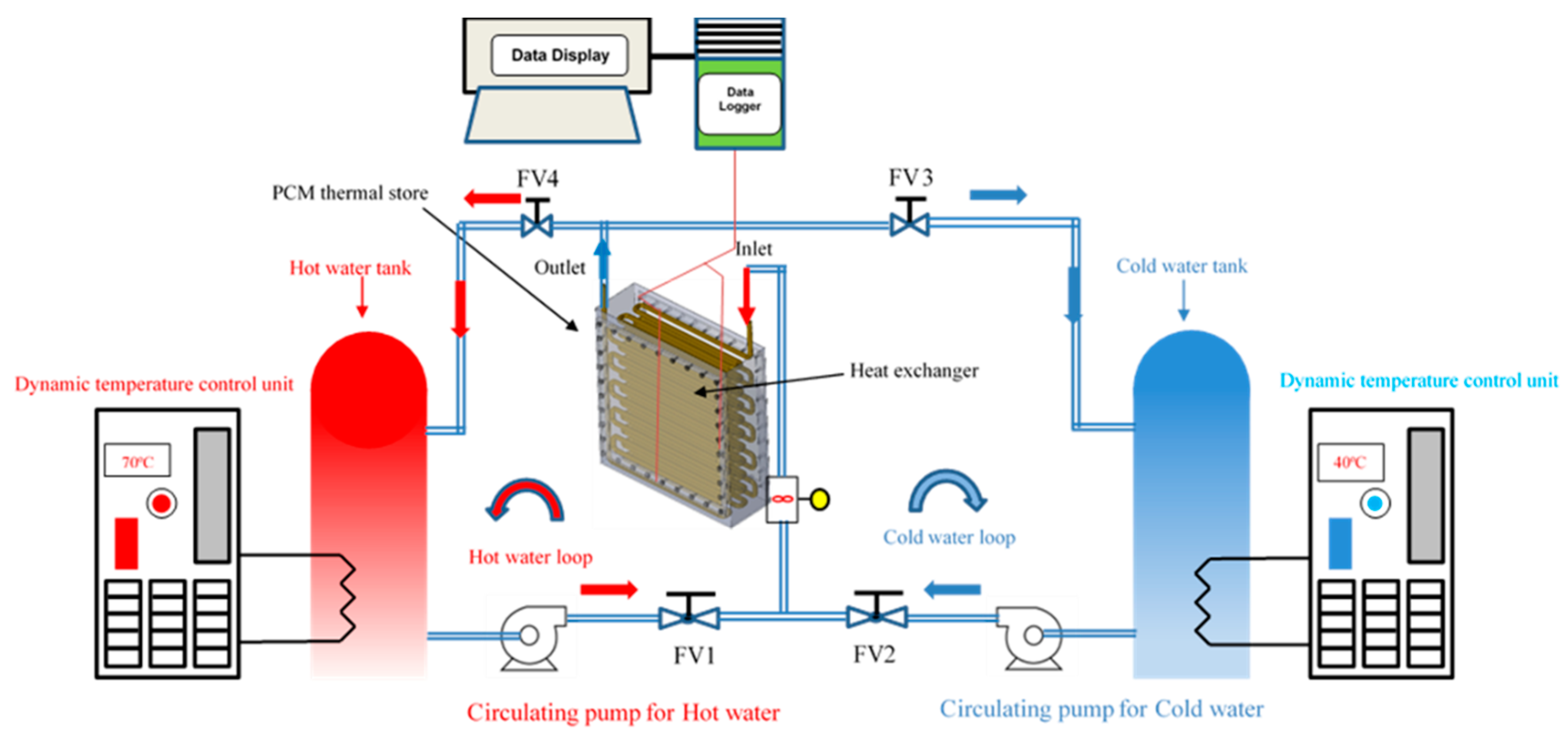

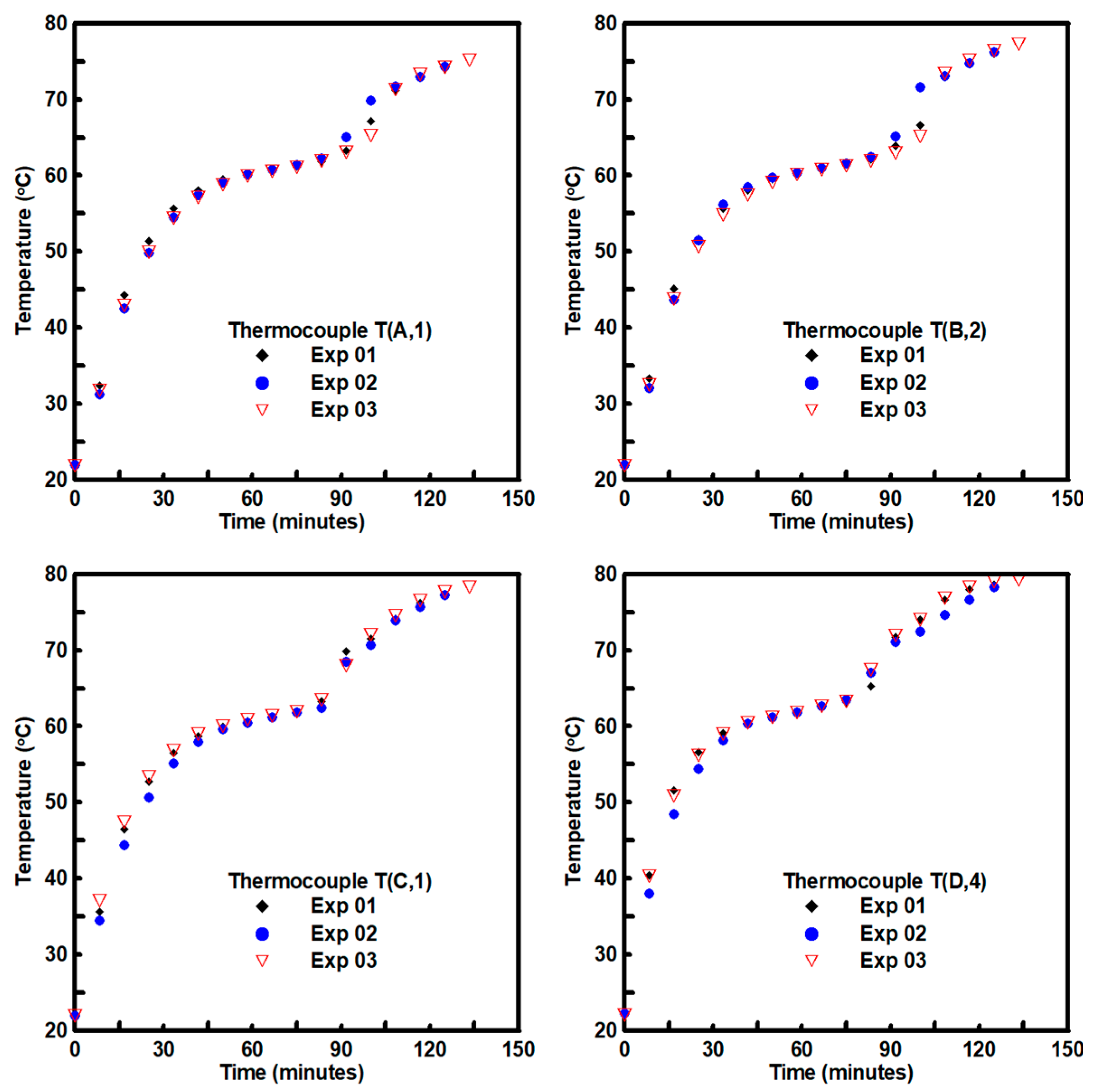
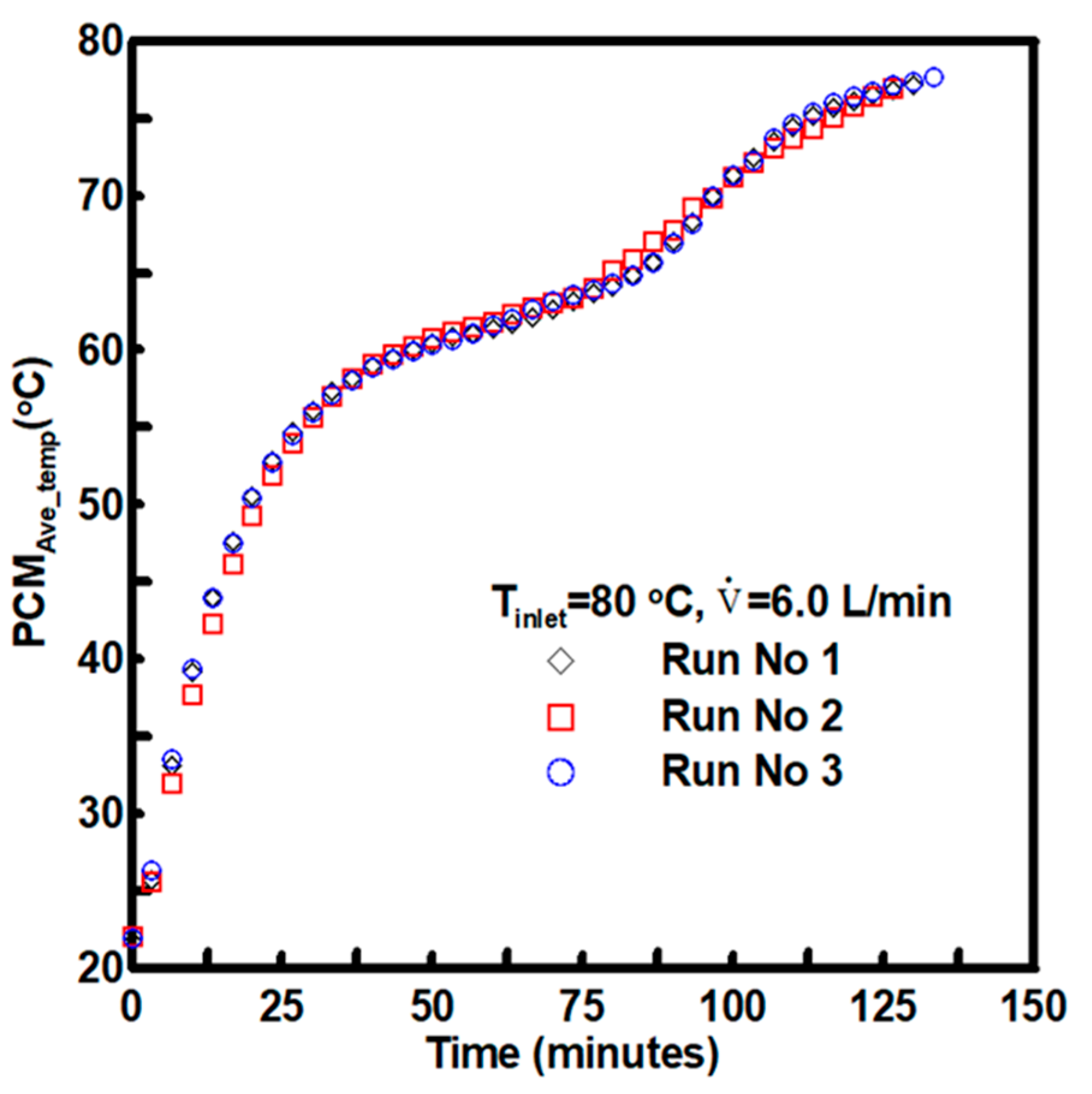
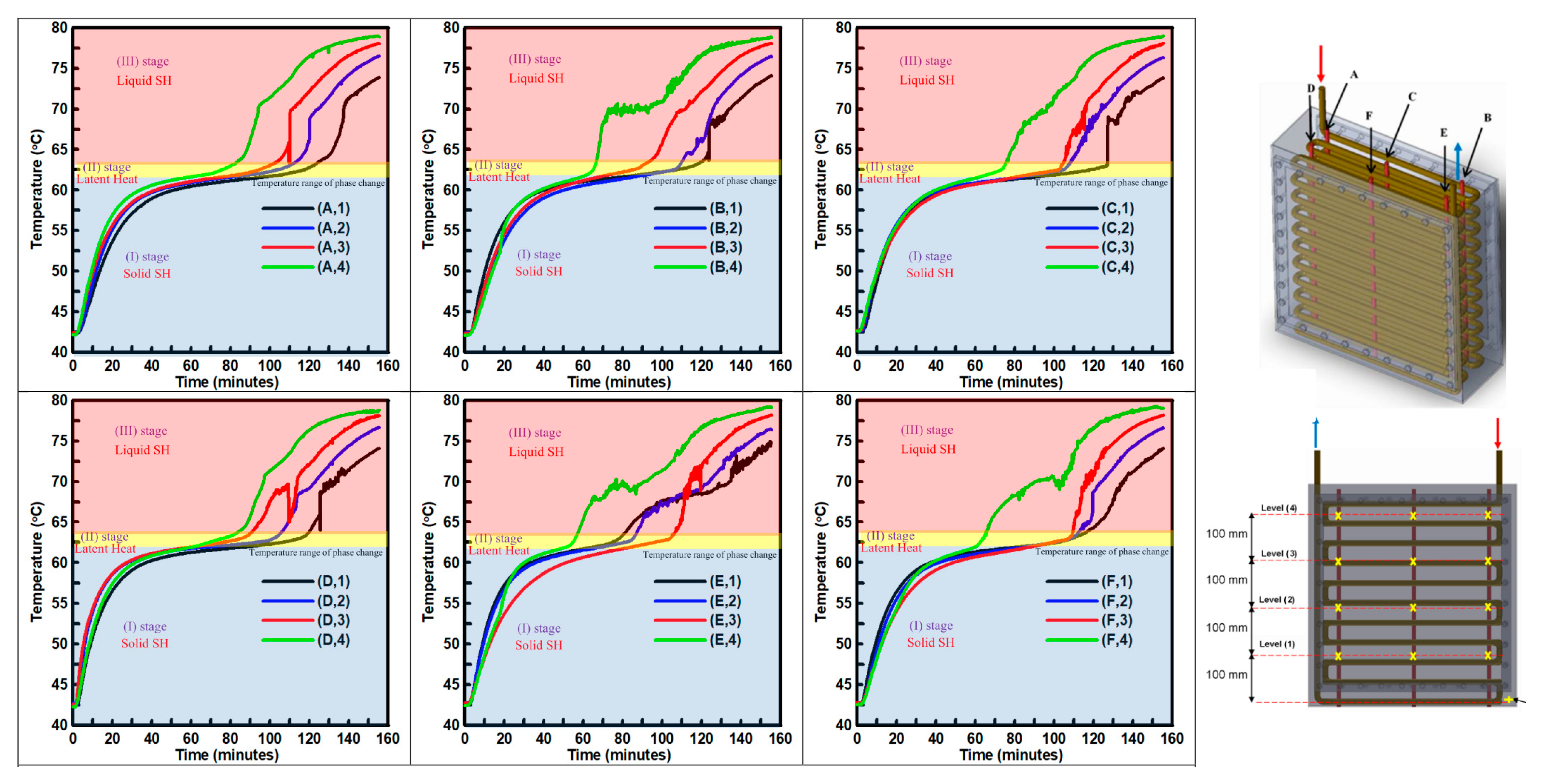

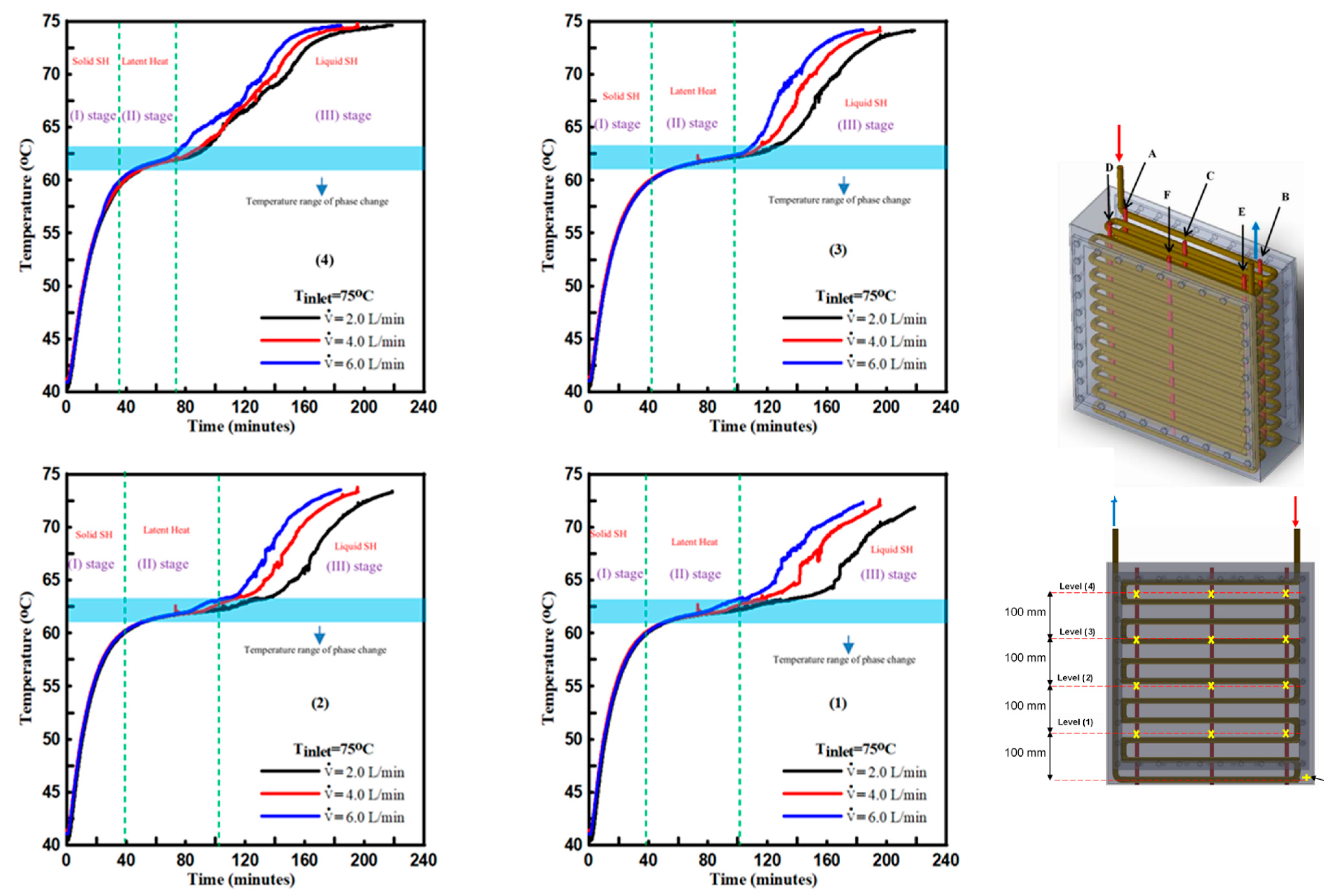
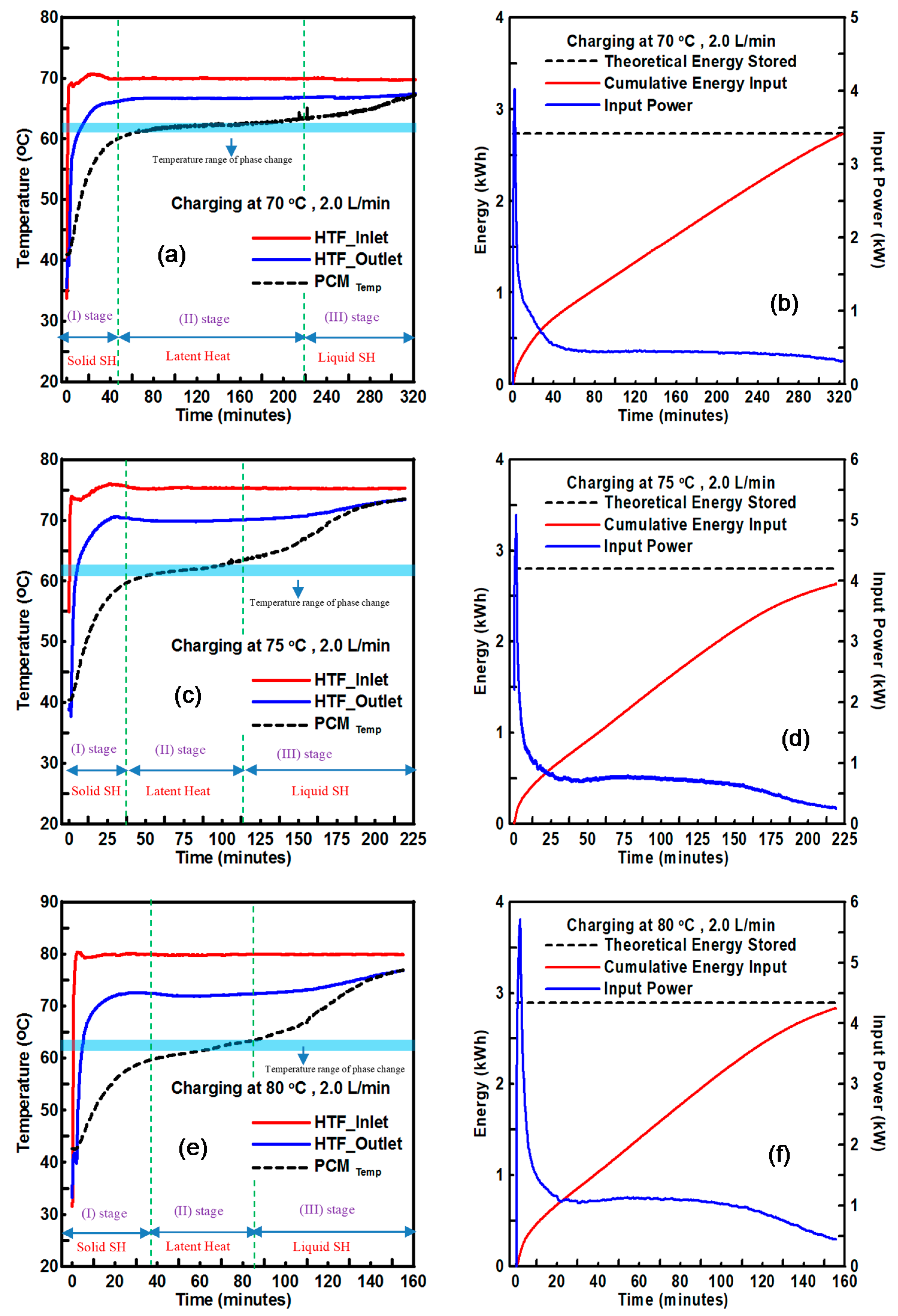
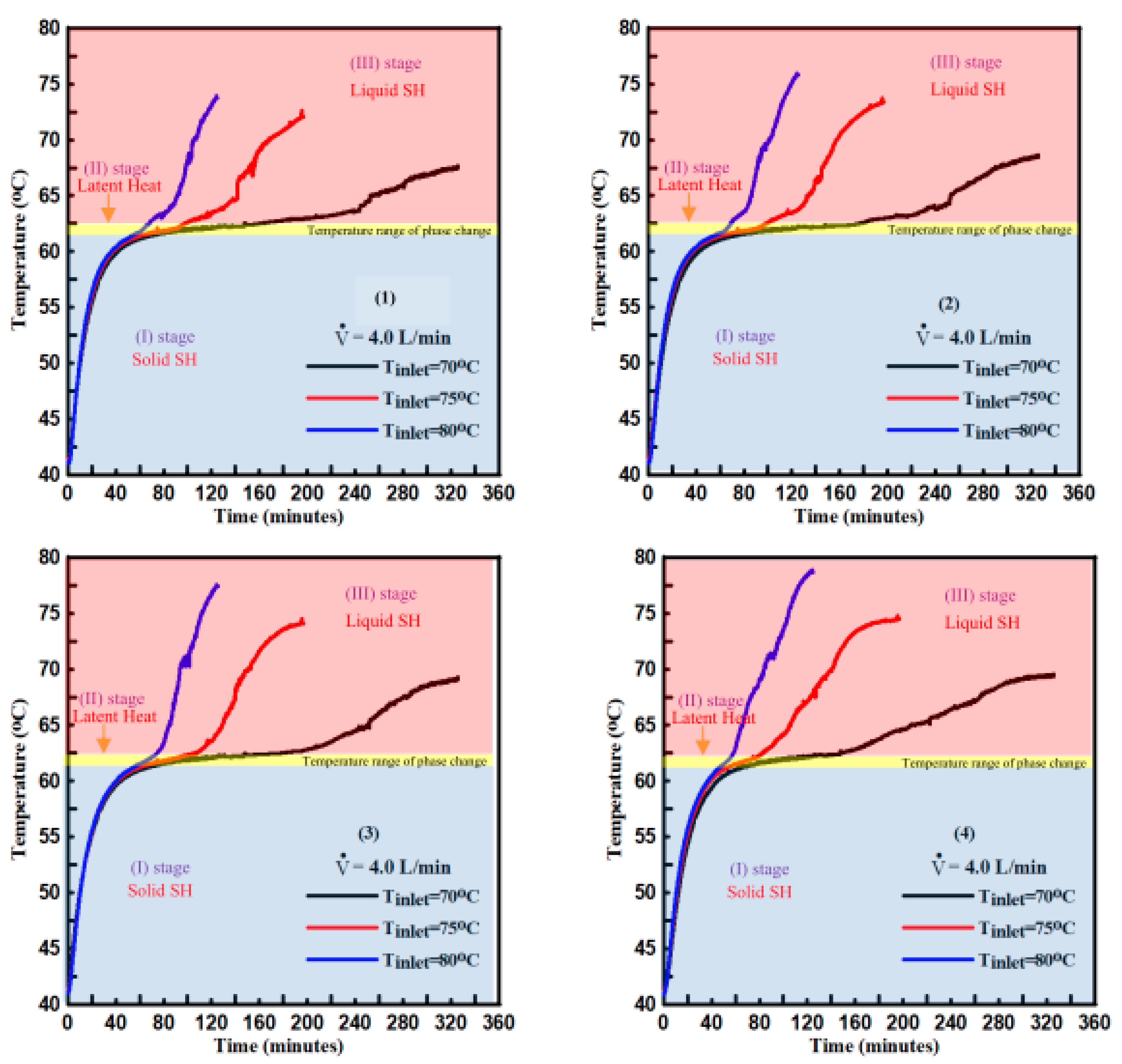
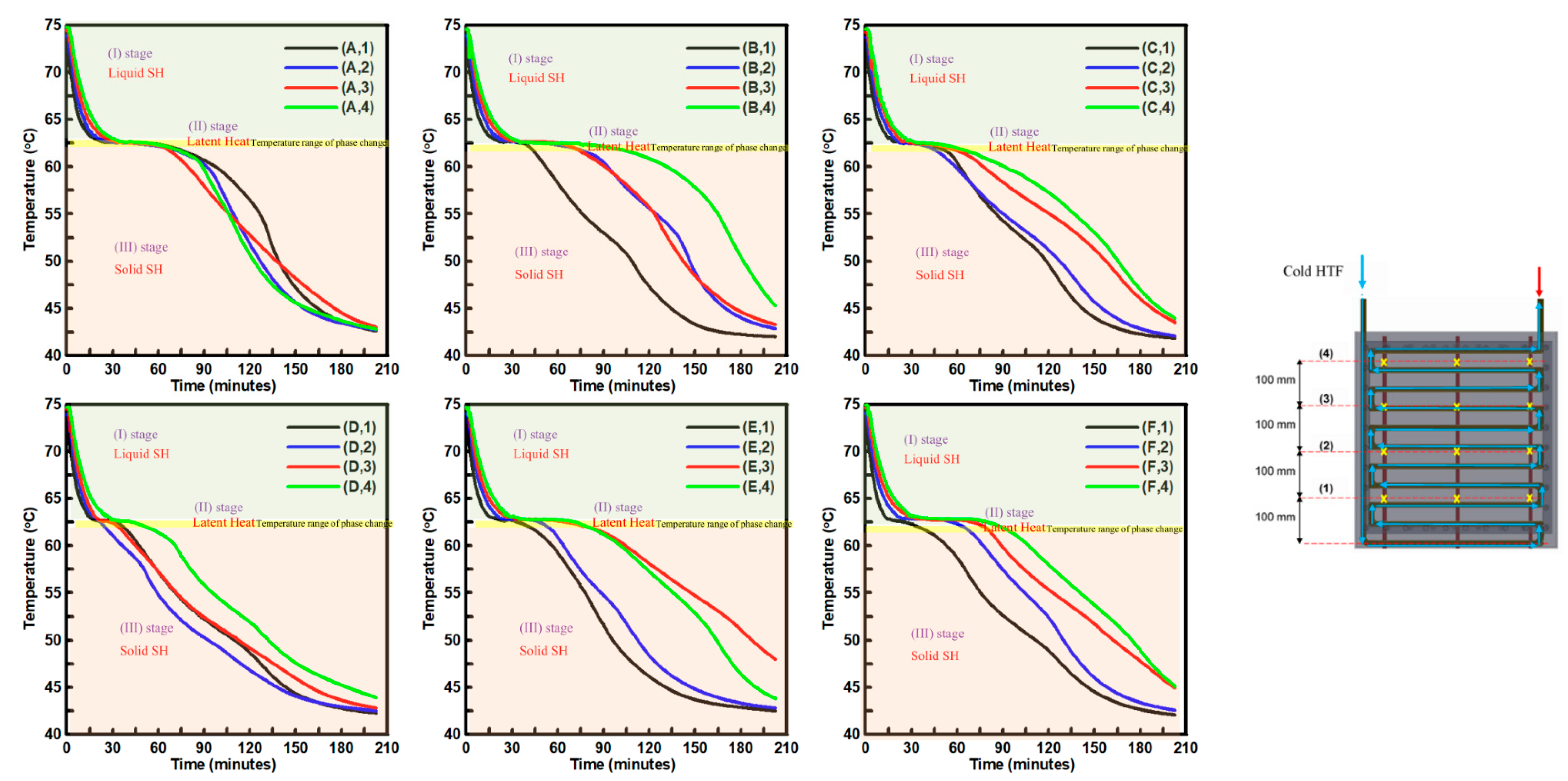
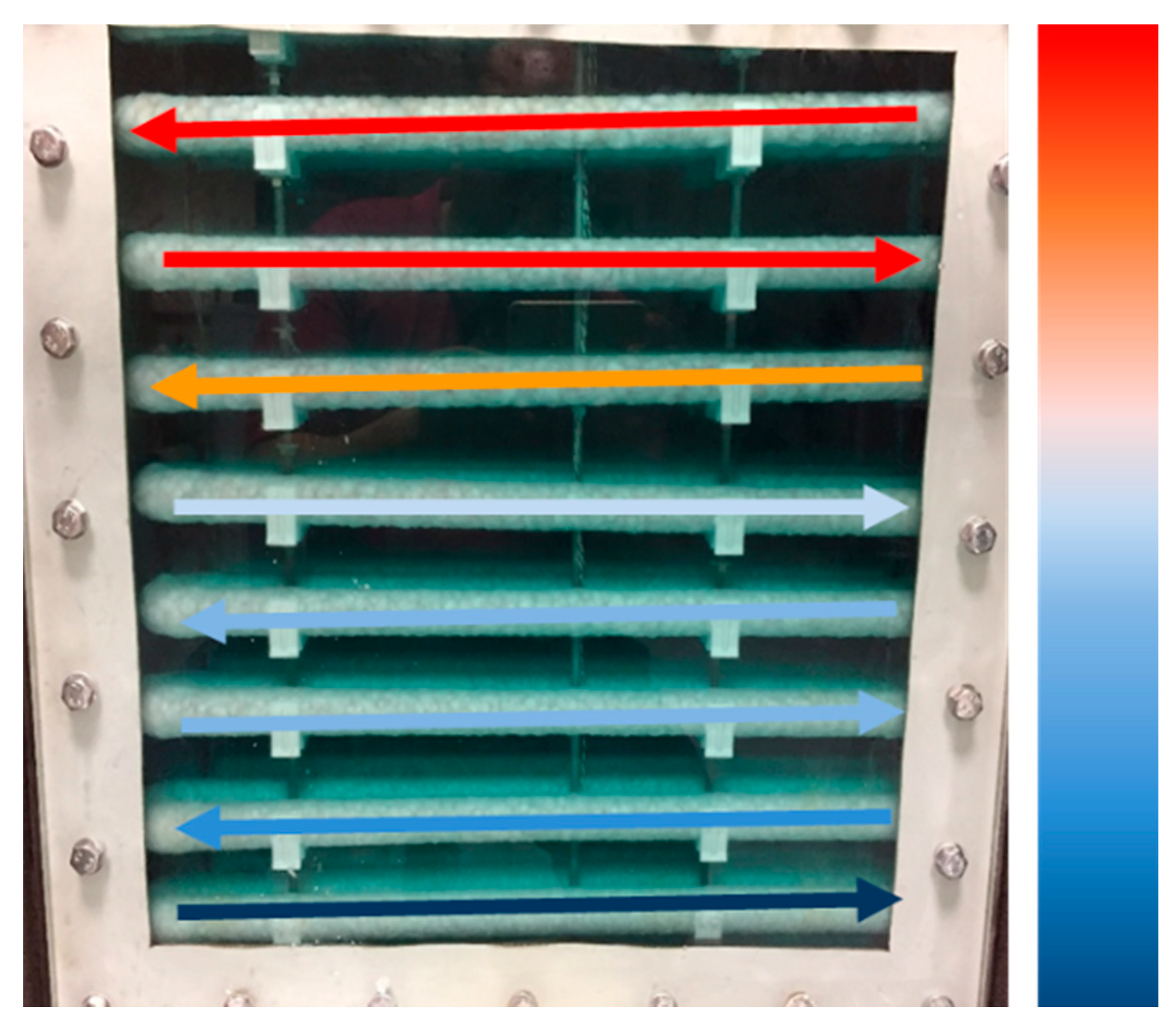

| Property | Value | Dimension |
|---|---|---|
| Melting temperature | 62–63 | °C |
| Congealing temperature | 62 | °C |
| Heat storage capacity, in a temperature range of 55 °C to 70 °C | 230 | kJ/kg |
| Density at 25 °C (solid) | 850 | kg/m3 |
| Density at 80 °C (liquid) | 840 | kg/m3 |
| Specific heat capacity (solid/liquid) | 2000 | J/(kg∙°C) |
| Thermal conductivity (solid/liquid) | 0.2 | W/(m∙°C) |
| HTF Inlet Temperature (°C) | Volume Flow Rate (L/min) | ReD | |
|---|---|---|---|
| Charging | 70 | 2 | 7738 |
| 75 | 2 | 8242 | |
| 80 | 2 | 8745 | |
| 70 | 4 | 15,477 | |
| 75 | 4 | 16,485 | |
| 80 | 4 | 17,490 | |
| 70 | 6 | 23,215 | |
| 75 | 6 | 24,727 | |
| 80 | 6 | 26,236 | |
| Discharging | 40 | 1.7 | 4138 |
| 40 | 2.3 | 5599 | |
| 40 | 5.1 | 12,415 |
| HTF Inlet Temperature (°C) | Stefan Number (Ste) | |
|---|---|---|
| Charging process | 70 | 0.077 |
| 75 | 0.128 | |
| 80 | 0.178 | |
| Discharging process | 40 ± 1.0 | 0.225 |
Publisher’s Note: MDPI stays neutral with regard to jurisdictional claims in published maps and institutional affiliations. |
© 2020 by the authors. Licensee MDPI, Basel, Switzerland. This article is an open access article distributed under the terms and conditions of the Creative Commons Attribution (CC BY) license (http://creativecommons.org/licenses/by/4.0/).
Share and Cite
Fadl, M.; Eames, P. Thermal Performance Analysis of the Charging/Discharging Process of a Shell and Horizontally Oriented Multi-Tube Latent Heat Storage System. Energies 2020, 13, 6193. https://doi.org/10.3390/en13236193
Fadl M, Eames P. Thermal Performance Analysis of the Charging/Discharging Process of a Shell and Horizontally Oriented Multi-Tube Latent Heat Storage System. Energies. 2020; 13(23):6193. https://doi.org/10.3390/en13236193
Chicago/Turabian StyleFadl, Mohamed, and Philip Eames. 2020. "Thermal Performance Analysis of the Charging/Discharging Process of a Shell and Horizontally Oriented Multi-Tube Latent Heat Storage System" Energies 13, no. 23: 6193. https://doi.org/10.3390/en13236193
APA StyleFadl, M., & Eames, P. (2020). Thermal Performance Analysis of the Charging/Discharging Process of a Shell and Horizontally Oriented Multi-Tube Latent Heat Storage System. Energies, 13(23), 6193. https://doi.org/10.3390/en13236193






